¡¡Hola usuarios de Hive!! ✨ ✨, el día de hoy nuevamente les estare enseñando a realizar patrones, la diferencia es que esta vez realizaremos el patrón básico para la confección de blusas para dama 👕 👩. A partir de este patrón se realizan los diferentes trazos de los diferentes modelos de blusas para mujeres, así que es indispensable aprender a realizarlo 😉😉.
Hello Hive users!! ✨ ✨, today again I will be teaching you to make patterns, the difference is that this time we will make the basic pattern for making blouses for women 👕 👩. The different lines of the different models of women's blouses are made from this pattern, so it is essential to learn how to do it 😉😉.
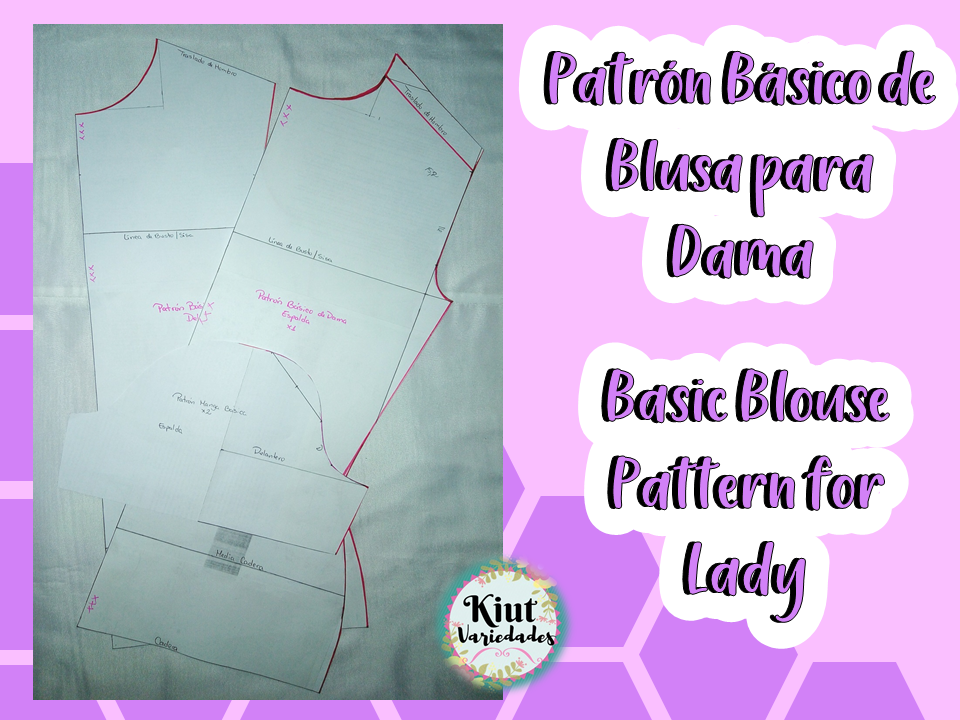

📐 ✏️ MATERIALES || MATERIALS 📐 ✏️
- Hojas.
- Cinta métrica.
- Regla y escuadras.
- Lápiz, lapicero o marcador.
- Tijera de papel.
- Reglas de patronaje (solo si las tienes).
- Leaves.
- Measuring tape.
- Ruler and squares.
- Pencil, pen or marker.
- Paper scissors.
- Pattern rules (only if you have them).
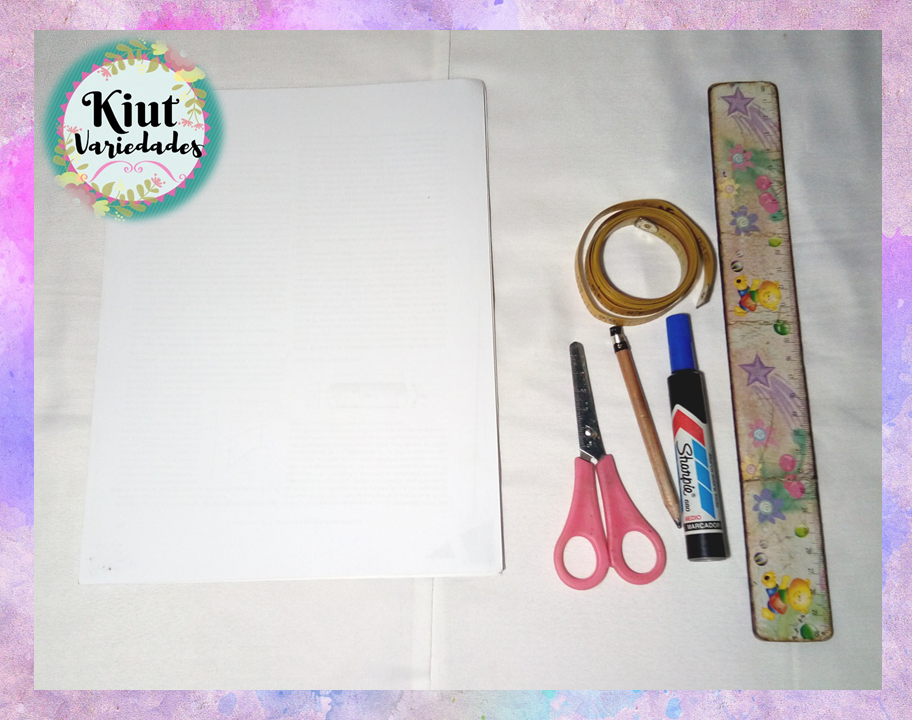

📐 ✏️ MANOS A LA OBRA || LET’S DO IT 📐 ✏️
Para realizar estos patrones vamos a necesitar varias medidas, y por varias quiero advertir que serán muchas 😂😂, antes de comenzar a tonar dichas medidas, primero coloca una tira o cuerda en la parte más delgada de nuestra cintura. Las medidas que necesitaremos son las siguientes:
- Contorno de Pecho: que se mide por la parte más prominente del pecho.
- Contorno de Cintura: que se toma por la parte más delgada de nuestra cintura
- Contorno de Cadera: que se toma por la parte más prominente de nuestra cadera.
- Altura de cadera: que va desde la cintura hasta el sitio donde hemos tomado el contorno de cadera.
- Altura de media cadera: que es la mitad de la altura de la cadera.
- Contorno de Media Cadera: que se toma donde dé el resultado de la altura de la media cadera.
- Talle delantero: esta medida la tomaremos de forma diferente, la tomaremos desde el punto más alto del hombro (vértice cuello-hombro), hasta la cintura por el centro, es decir de manera diagonal.
- Talle Espalda: se toma igual que el talle delantero, pero en la espalda.
- Centro frente: que va desde el punto más alto del cuello (donde se siente el hueso) hasta la cintura, por toda la línea central.
- Centro Espalda: va desde el punto más alto del cuello por la espalda, hasta la cintura por toda la línea central.
- Caída de Hombro delantero: Se toma desde la parte central de la cintura hasta el final del hombro, es decir hasta el punto acromion, también es una medida que en diagonal.
- Caída de Hombro espalda: se toma igual que el anterior, pero en la espalda.
- Ancho de Pecho: Se toma desde el pliegue del brazo, pasando por encima del pecho hasta el otro pliegue.
- Ancho de Espalda: Se toma desde el punto acromion de un brazo hasta el otro pasando por encima del hombro.
- Costado: va desde la cintura, hasta el comienzo de la axila.
- Largo de Manga: se toma desde el punto acromion hasta el largo deseado.
- Contorno de Brazo/Muñeca: se toma rodeando el brazo o la muñeca y dejando un poco de holgura.
To make these patterns we are going to need several measurements, and for several I want to warn that there will be many 😂😂, before starting to tone these measurements, first place a strip or rope in the thinnest part of our waist. The measurements that we will need are the following:
- Chest Contour: which is measured by the most prominent part of the chest.
- Waist Contour: that is taken from the thinnest part of our waist
- Hip Contour: that is taken from the most prominent part of our hips.
- Hip height: that goes from the waist to the place where we have taken the hip contour.
- Mid-hip height: which is half the height of the hip.
- Mid-Hip Contour: taken where the height of the mid-hip gives the result.
- Front size: we will take this measurement differently, we will take it from the highest point of the shoulder (neck-shoulder vertex), up to the waist in the center, that is to say diagonally.
- Back Size: is taken the same as the front size, but at the back.
- Center forehead: that goes from the highest point of the neck (where the bone is felt) to the waist, along the entire center line.
- Center Back: goes from the highest point of the neck down the back, to the waist along the entire center line.
- Front Shoulder Drop: It is taken from the central part of the waist to the end of the shoulder, that is to say to the acromion point, it is also a diagonal measurement.
- Back Shoulder Drop: is taken the same as the previous one, but on the back.
- Chest Width: It is taken from the fold of the arm, passing over the chest to the other fold.
- Back Width: It is taken from the acromion point of one arm to the other, passing over the shoulder.
- Side: goes from the waist to the beginning of the armpit.
- Sleeve Length: is taken from the acromion point to the desired length.
- Arm / Wrist Contour: it is taken by surrounding the arm or wrist and leaving a little slack.

📐 ✏️ PARTE I: DELANTERO || PART I: FRONT 📐 ✏️
Comenzamos trazando un rectángulo que tenga de ancho la mitad de la medida de ancho de espalda y de largo la medida del talle delantero. En la esquina superior hacia la derecha mediremos 1/6 del contorno de cuello, es decir, la medida del contorno del cuello la dividiremos entre 6. Desde la parte inferior hacia arriba marcaremos con la medida del centro frente, y esta marca la uniremos a la otra que habíamos realizado formando la curva del escote.
We start by drawing a rectangle that is half the width of the back width measurement and the length of the front waist measurement. In the upper corner to the right we will measure 1/6 of the neck contour, that is, the measurement of the neck contour will be divided by 6. From the bottom part up we will mark with the measurement of the center front, and this mark will be joined to the other that we had made by forming the curve of the neckline.
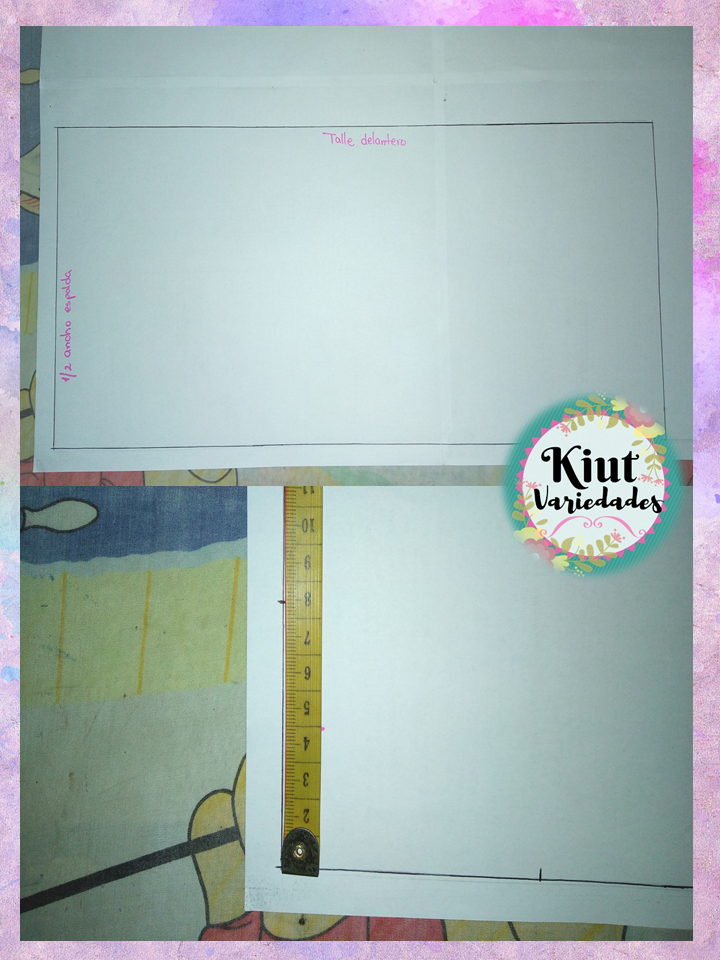
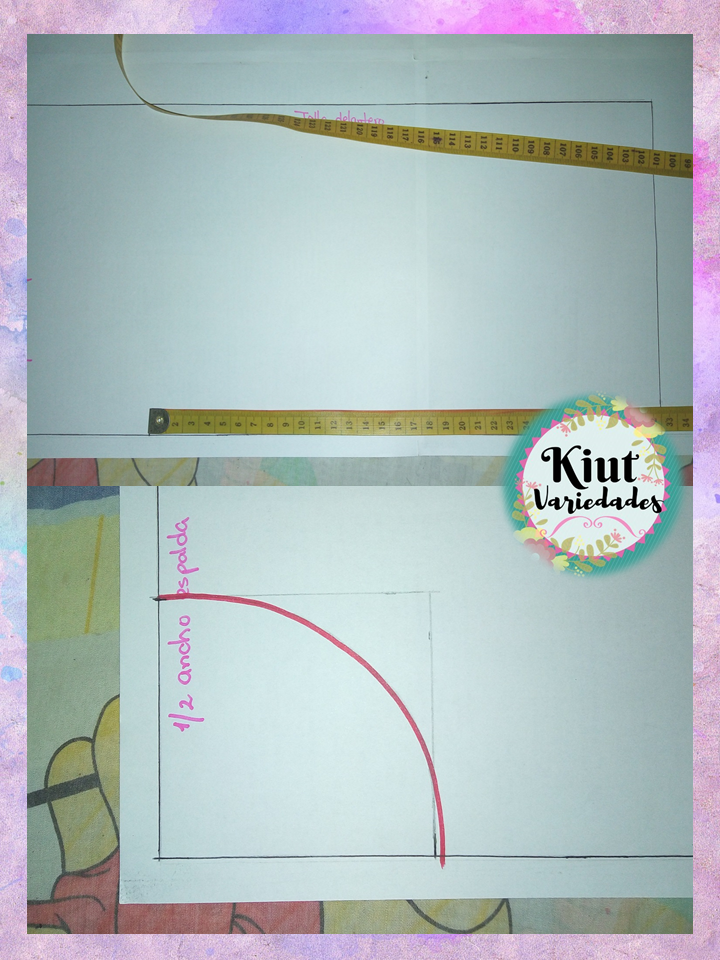
Desde la esquina inferior mediremos la caída de hombro delantera en dirección a la línea derecha, de forma diagonal. Esta marca la uniremos con línea recta a la parte superior del cuello, formando así la línea de hombro.
From the bottom corner we will measure the front shoulder drop in the direction of the right line, diagonally. We will join this mark with a straight line to the upper part of the neck, thus forming the shoulder line.
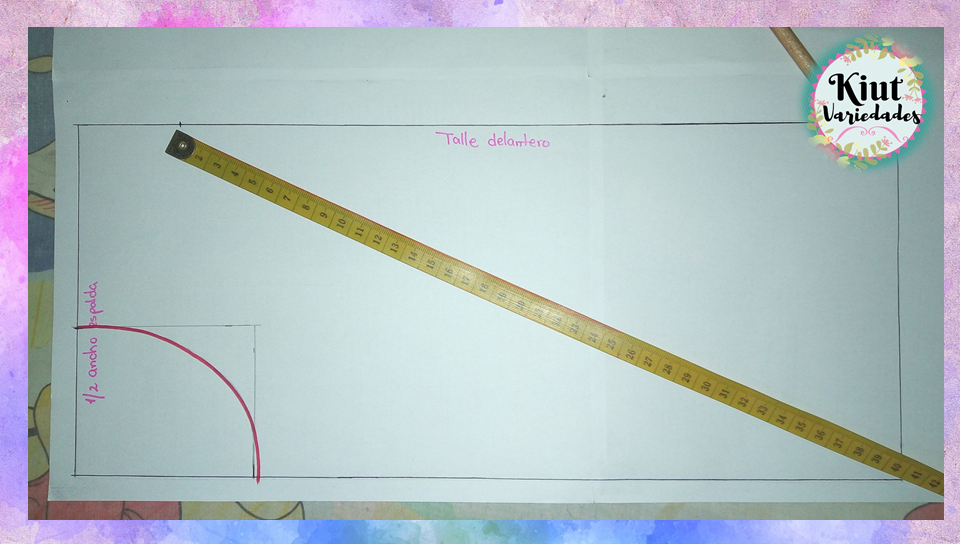

Desde la parte inferior hacia arriba, mediremos el costado y escuadraremos esa marca con ¼ del contorno de pecho, la medida del contorno de pecho dividida entre 4, esta será la línea de pecho/sisa. Mediremos la distancia entre el vértice de cuello y esta línea, y a la mitad de esta medida haremos una marca, la cual escuadraremos con la mitad de la medida de ancho de pecho. Formaremos la curva de la sisa.
From the bottom up, we will measure the side and we will square that mark with ¼ of the chest contour, the measurement of the chest contour divided by 4, this will be the chest / armhole line. We will measure the distance between the vertex of the neck and this line, and in the middle of this measurement we will make a mark, which we will square with half the measurement of chest width. We will form the curve of the armhole.
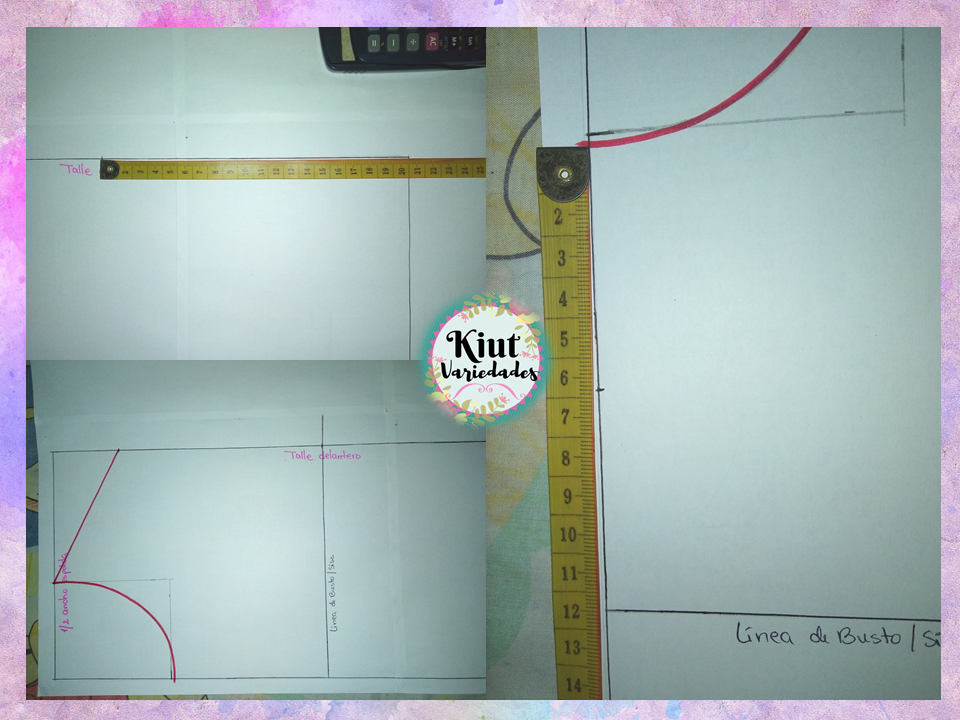
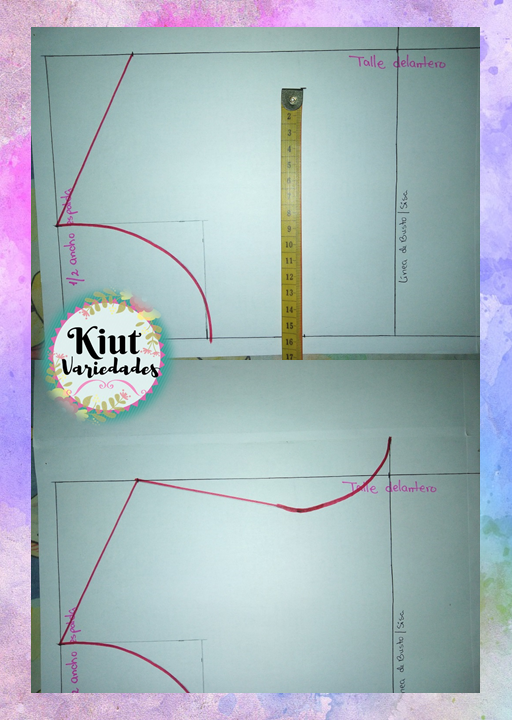
En la parte inferior mediremos ¼ del contorno de cintura y uniremos esta marca con línea recta a la sisa. Luego mediremos desde la línea de cintura hacia abajo, la medida de altura de cadera y media cadera, y escuadraremos estas marcas con la medida de ¼ de contorno de cadera y media cadera respectivamente.
In the lower part we will measure ¼ of the waist contour and we will join this mark with a straight line to the armhole. Then we will measure from the waist line down, the measurement of hip and half hip height, and we will square these marks with the measurement of ¼ of hip and half hip contour respectively.
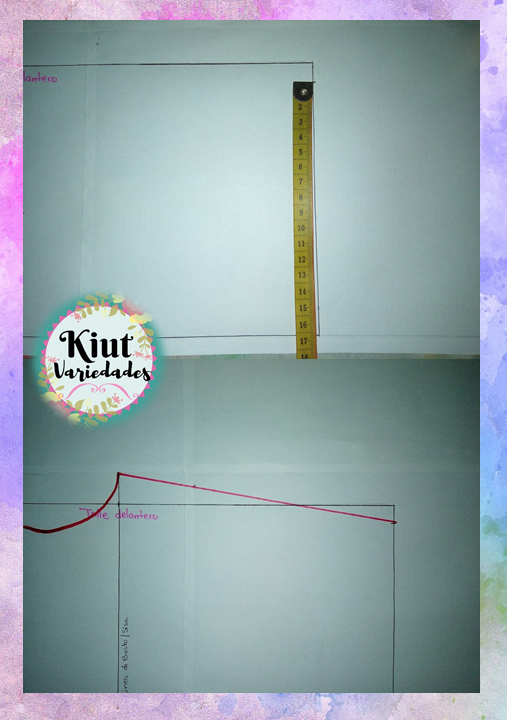

Uniremos estas marcas con una curva, si en la cintura se forma un ángulo muy marcado (como es mi caso), debemos suavizar esa curva.
We will join these marks with a curve, if a very marked angle is formed at the waist (as is my case), we must smooth that curve.

En la parte del hombro haremos una modificación, en la línea de hombro quitaremos 2 cm y a esto llamaremos traslado de hombro.
In the part of the shoulder we will make a modification, in the shoulder line we will remove 2 cm and we will call this shoulder transfer.
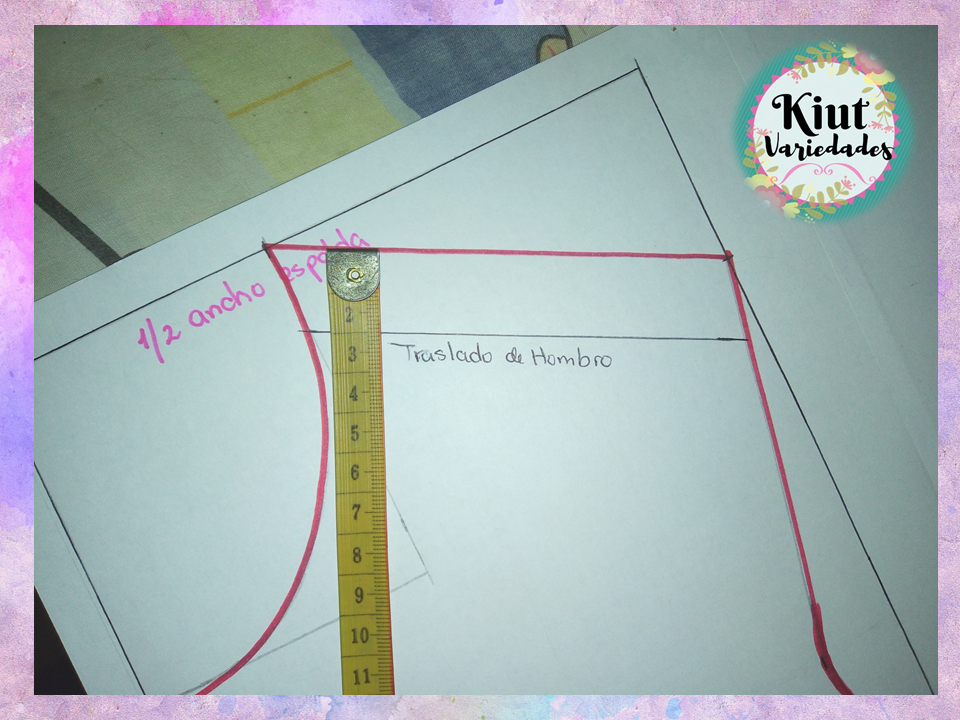

📐 ✏️ PARTE II: ESPALDA || PART II: BACK 📐 ✏️
El patrón de la espalda se realiza básicamente de la misma manera, igual se comienza con un rectángulo que tenga de ancho la mitad del ancho de la espalda, y de largo la medida del talle de la espalda. En la esquina superior se marca 1/6 del contorno de cuello, y desde la parte inferior hacia arriba se marca la medida del centro espalda, para formar la curva del escote.
The back pattern is basically done in the same way, starting with a rectangle that is half the width of the back, and the length of the back waist. In the upper corner 1/6 of the neck contour is marked, and from the bottom upwards the measurement of the center back is marked, to form the curve of the neckline.
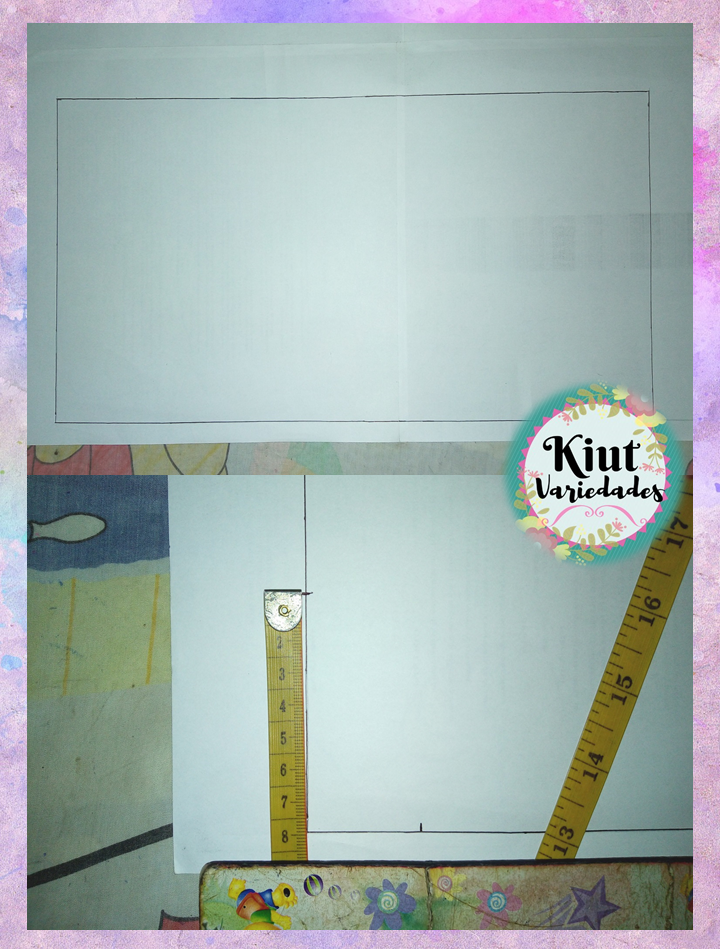
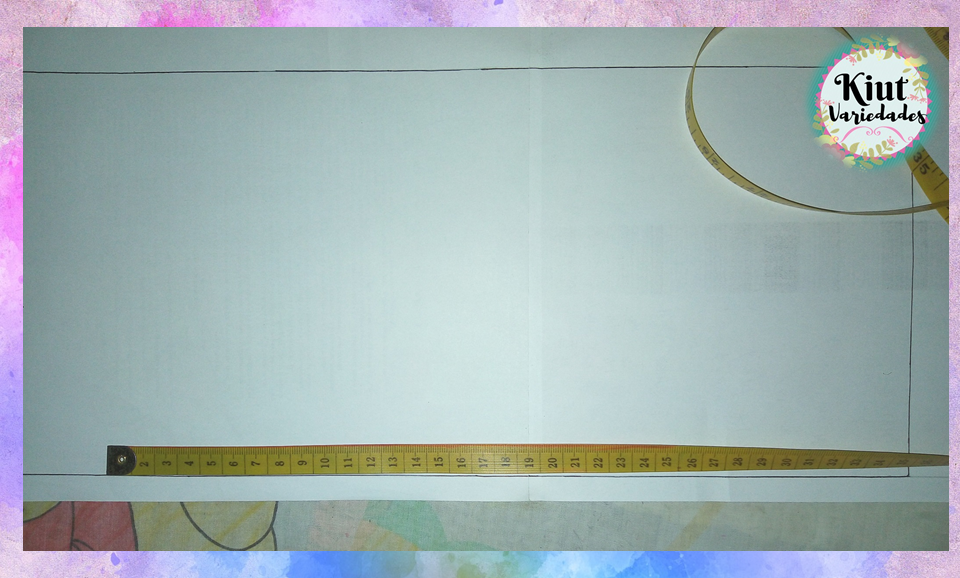
Igualmente desde la esquina inferior hacia la línea derecha, en forma diagonal, mediremos la caída de hombro espalda y uniremos esta marca con la parte superior del cuello, formando la línea de hombro.
Likewise, from the lower corner to the right line, diagonally, we will measure the back shoulder drop and join this mark with the upper part of the neck, forming the shoulder line.
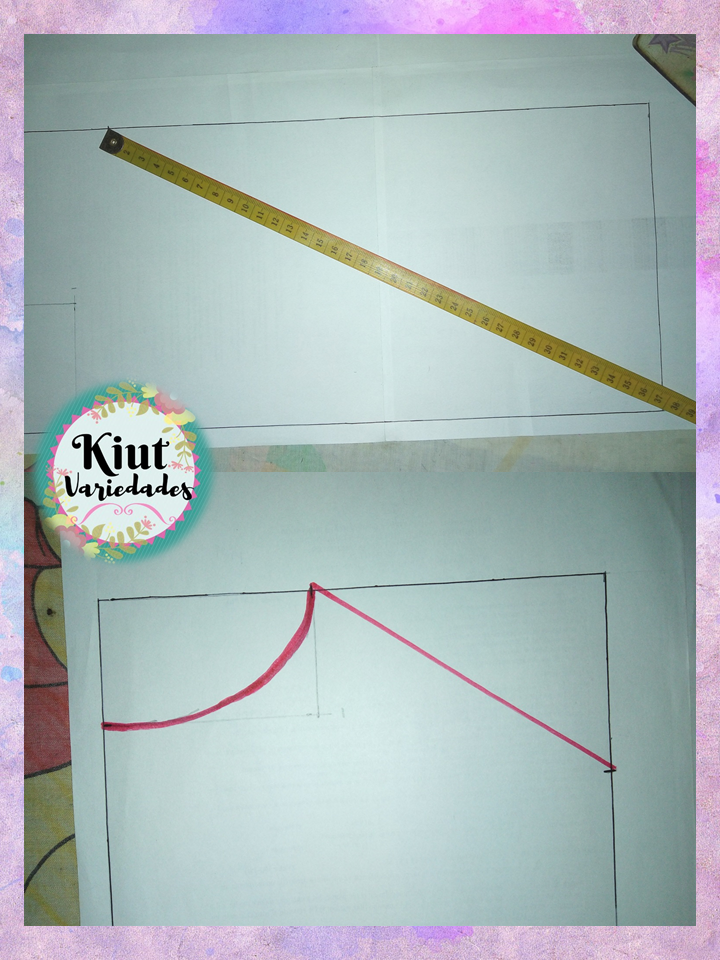
Medimos el costado, desde la parte inferior hacia arriba, y escuadraremos con ¼ del contorno de pecho. Para realizar la curva de la sisa, si lo haremos diferente que en el delantero, para hacerlo tomaremos la medida que hay entre la línea del rectángulo, y el final de la línea de pecho, y dicha medida la trasladaremos hacia arriba, y formaremos la curva de la sisa.
We measure the side, from the bottom up, and we will square with ¼ of the chest contour. To make the curve of the armhole, if we will do it differently than in the front, to do so we will take the measurement that exists between the line of the rectangle, and the end of the chest line, and this measurement will be transferred upwards, and we will form the curve of the armhole.
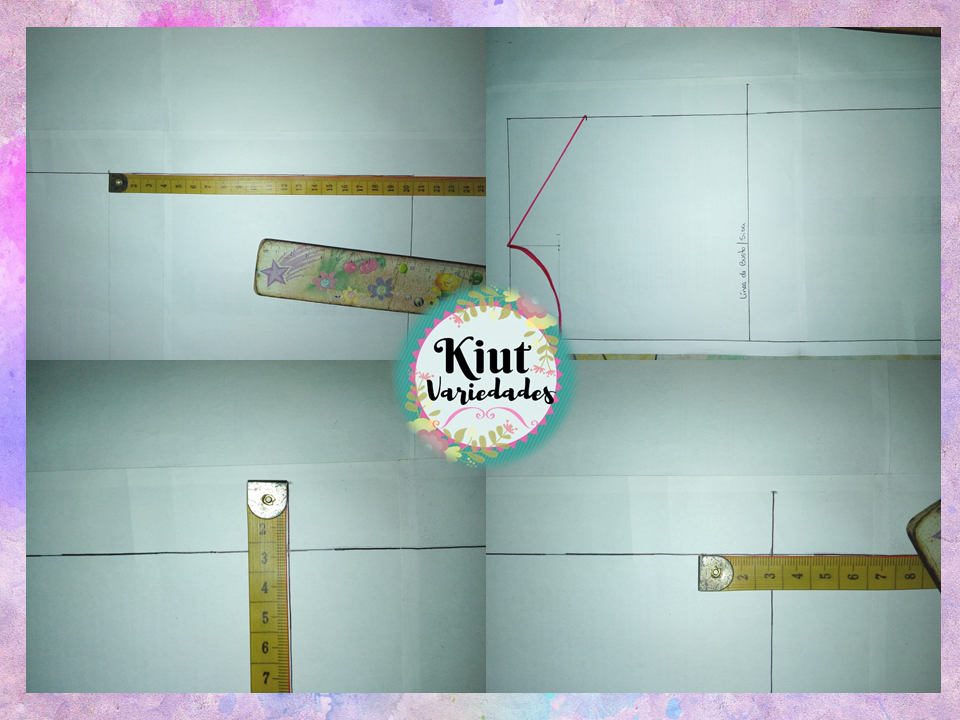
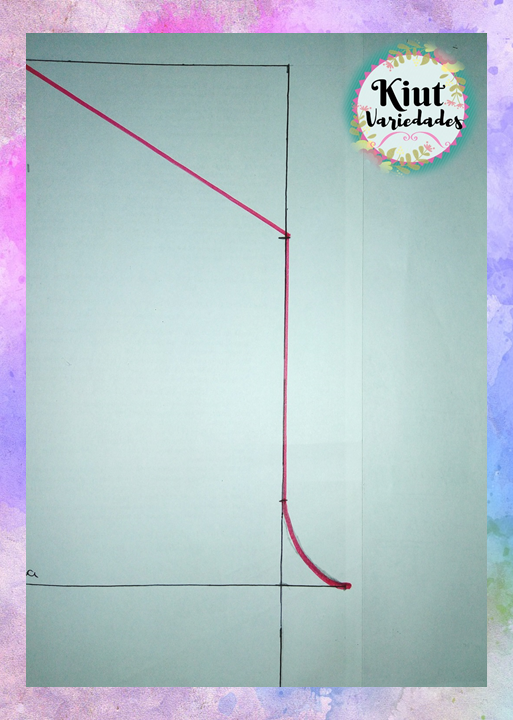
Lo que resta es igual al patrón delantero, medir ¼ del contorno de cintura y unir con línea recta a la sisa, medir la altura de cadera y media cadera y escuadrar con ¼ del contorno de cadera y media cadera respectivamente, y unir con curva estos puntos.
What remains is equal to the front pattern, measure ¼ of the waist contour and join with a straight line to the armhole, measure the height of the hip and half hip and square with ¼ of the hip and half hip contour respectively, and join with curve these points.
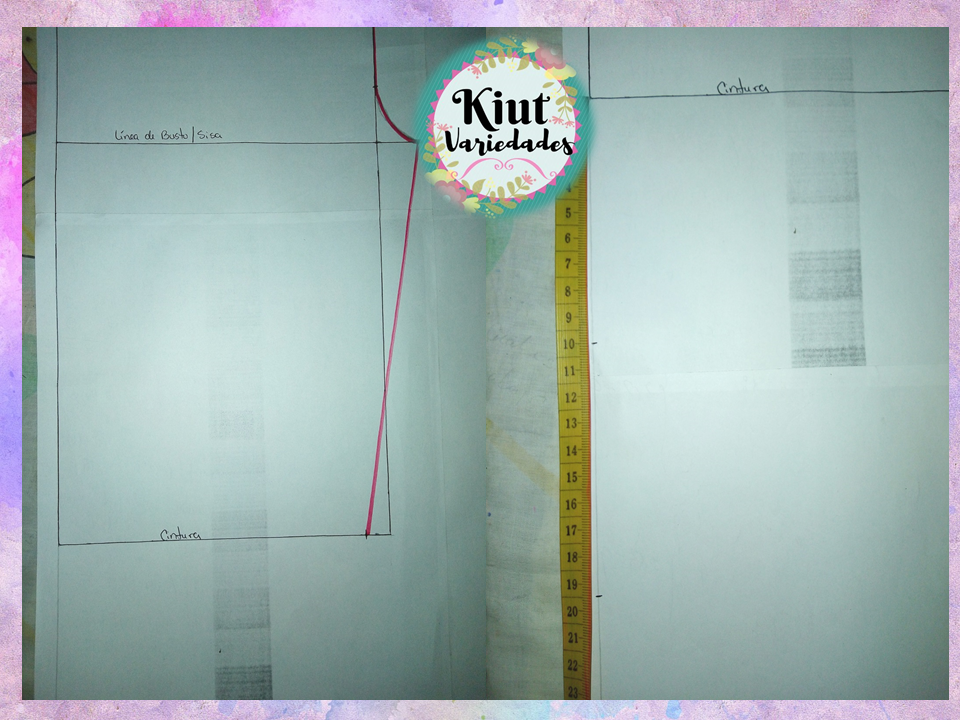

Y para finalizar este trazo, haremos el traslado de hombro. Si en el patrón delantero quitamos 2 cm, aquí añadiremos 2 cm.
And to finish this stroke, we will do the shoulder transfer. If in the front pattern we remove 2 cm, here we will add 2 cm.
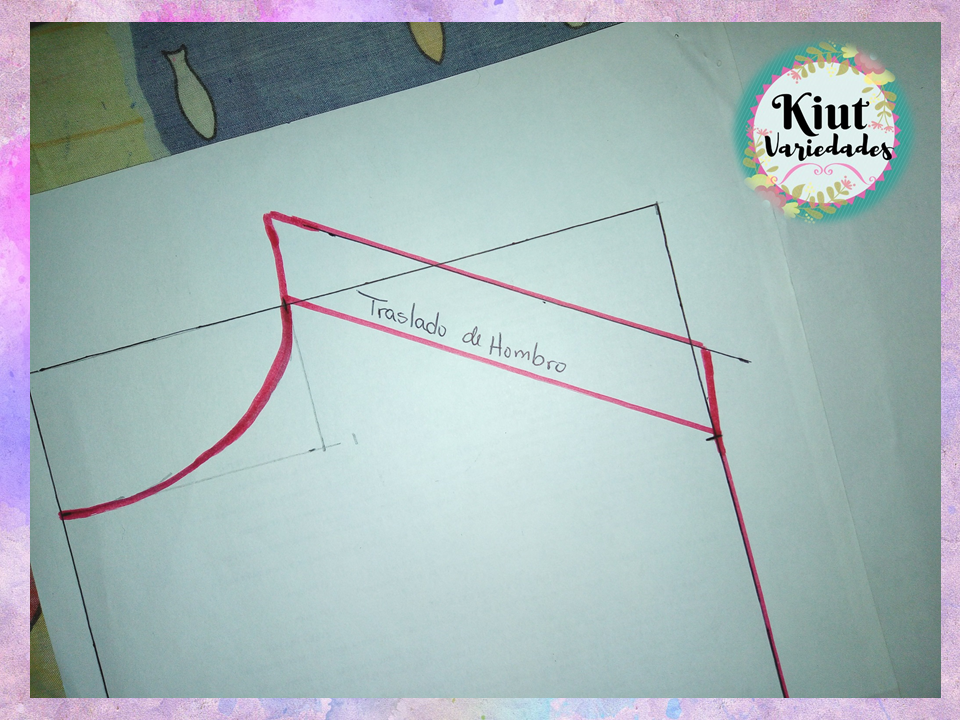

📐 ✏️ PARTE III: MANGA || PART III: SLEEVE 📐 ✏️
Para la manga trabajaremos con el papel doblado, desde la parte superior hacia abajo marcaremos el largo deseado de la manga y escuadraremos esa marca, sobre esa línea marcaremos la mitad del contorno de brazo/muñeca.
For the sleeve we will work with the folded paper, from the top down we will mark the desired length of the sleeve and we will square that mark, on that line we will mark the middle of the arm / wrist contour.
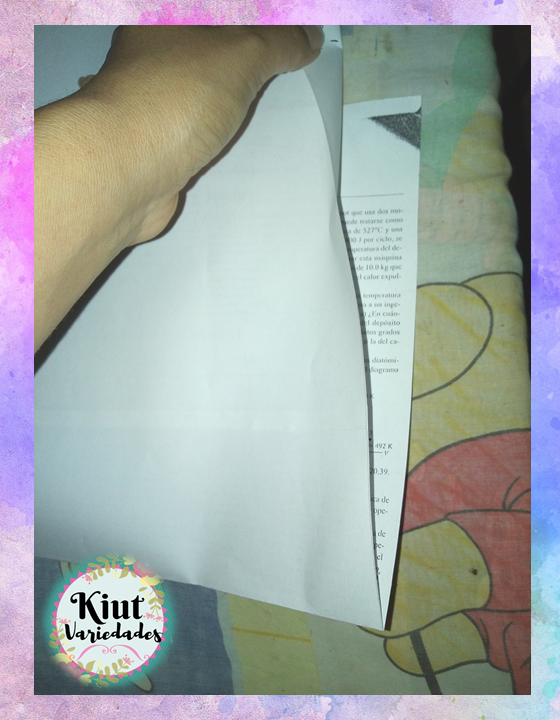
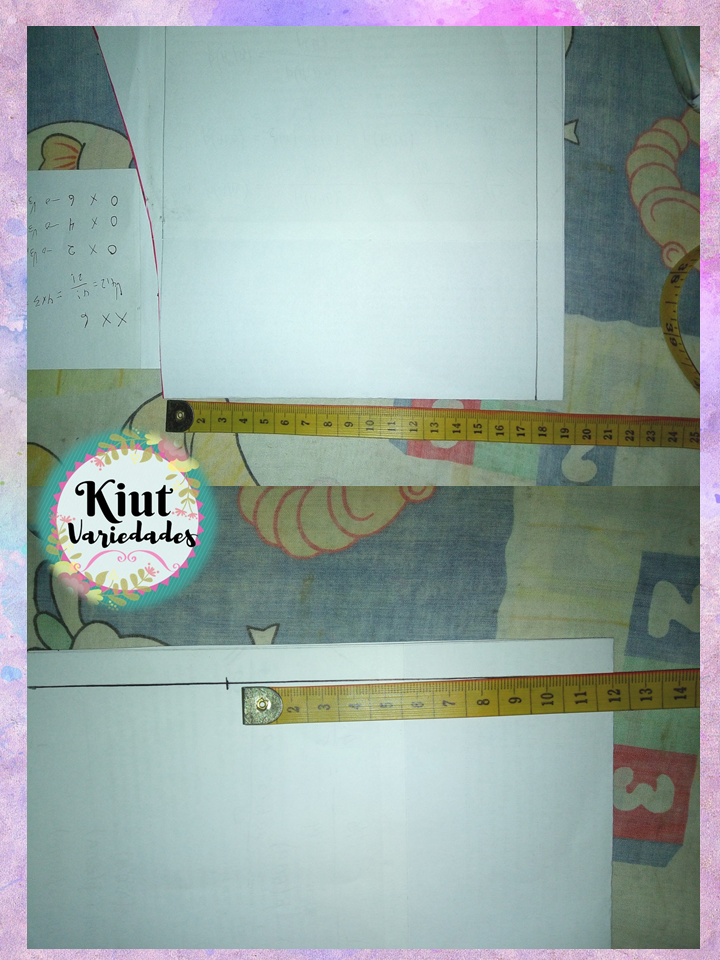
Mediremos la sisa delantera en línea recta, así como se muestra en la imagen, a dicha medida le restaremos 1 cm y el resultado lo marcaremos en la parte superior hacia la derecha, y escuadraremos esa marca, este será el ancho de la copa de la manga.
We will measure the front armhole in a straight line, as shown in the image, from this measurement we will subtract 1 cm and the result will be marked at the top to the right, and we will square that mark, this will be the width of the cup of the sleeve.
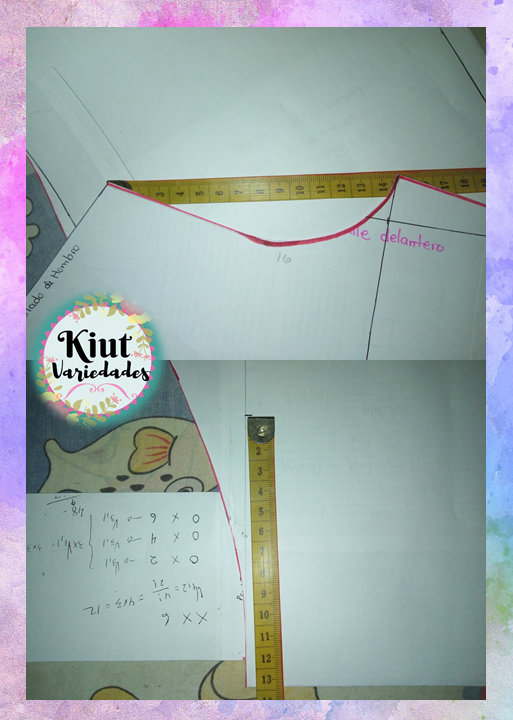
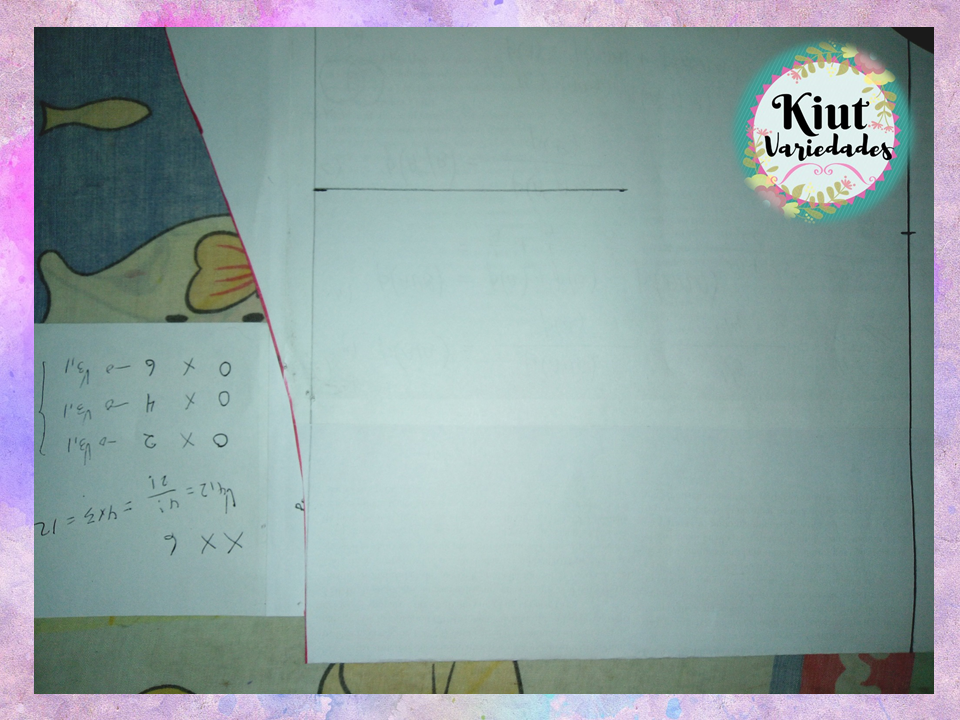
Para la altura de copa, mediremos la sisa de la espalda, nuevamente en línea recta, esta medida la multiplicaremos por 2 y el resultado lo dividiremos entre 3, y el resultado será el que marcaremos en el papel, desde la parte superior hacia abajo y escuadramos.
For the height of the cup, we will measure the armhole of the back, again in a straight line, this measurement will be multiplied by 2 and the result will be divided by 3, and the result will be the one that we will mark on the paper, from the top down and squad.

En la esquina superior mediremos 1,5 cm hacia la derecha, y uniremos esta marca con el vértice que se ha formado entre el ancho y altura de copa. Luego mediremos esta línea y la dividiremos en 4 partes iguales.
In the upper corner we will measure 1.5 cm to the right, and we will join this mark with the vertex that has been formed between the width and height of the cup. Then we will measure this line and divide it into 4 equal parts.
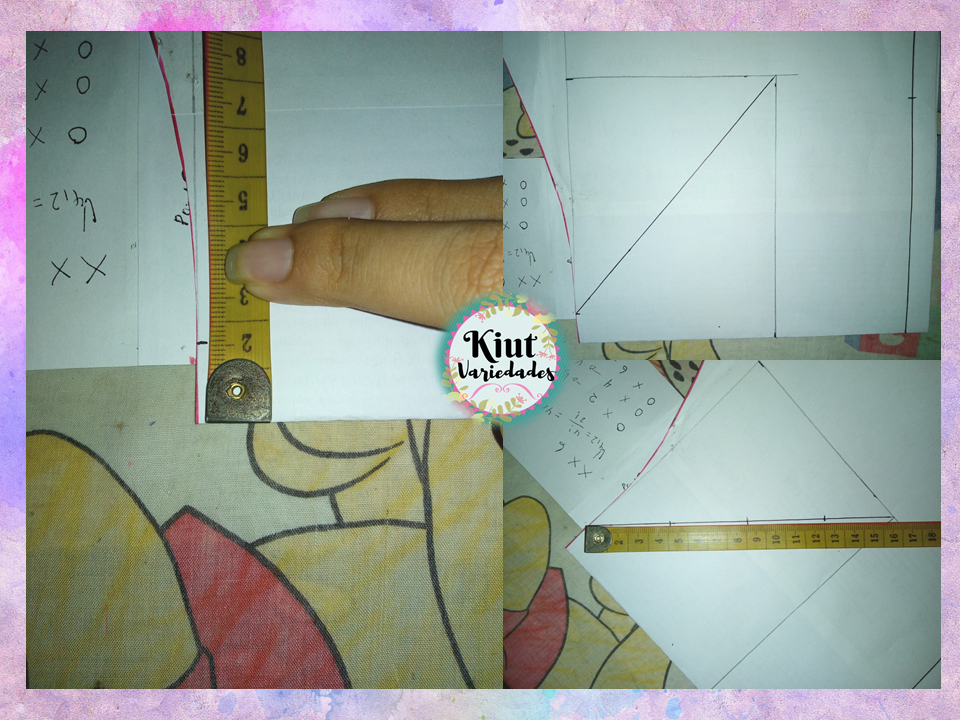
Desde la primera marca subiremos 1,5cm y desde la tercera marca bajaremos 1,5cm y trazaremos la copa de la manga delantera. Para trazar la copa de la manga de la espalda, subiremos 1cm en la segunda marca, es decir la del medio, y trazamos una nueva copa.
From the first mark we will go up 1.5cm and from the third mark we will go down 1.5cm and trace the cup of the front sleeve. To trace the cup on the back sleeve, we will go up 1cm at the second mark, that is, the middle one, and trace a new cup.
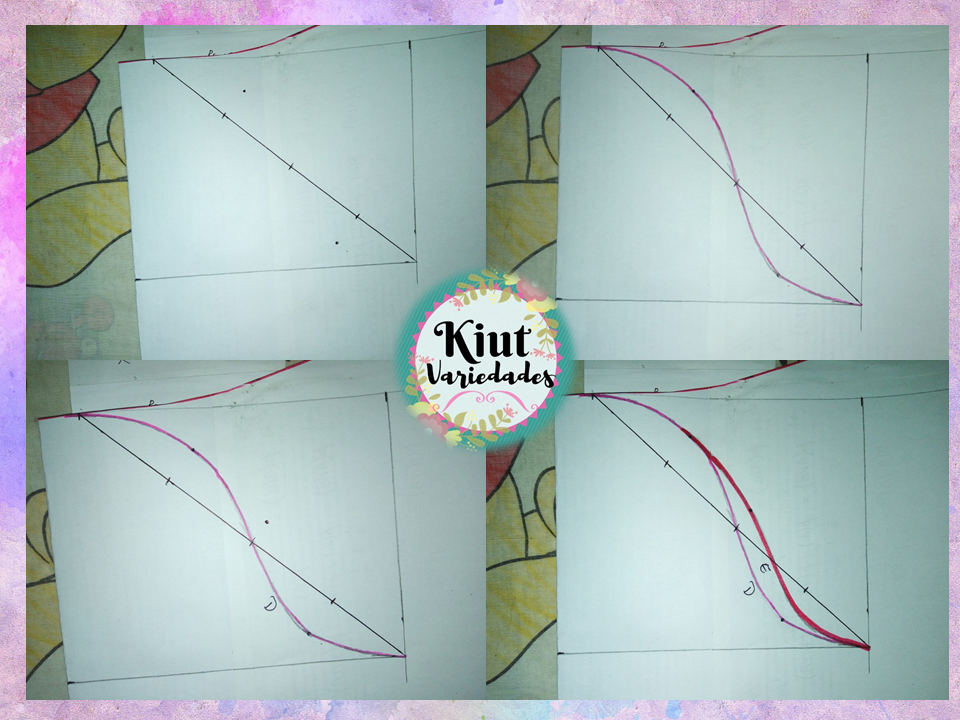
Unimos con una línea recta el punto de la sisa, con la marca de la parte inferior, la que nos señala la mitad del contorno de brazo/muñeca. Para recortar la manga, lo haremos con el papel doblado y en la parte de la copa, cortaremos por la curva de la espalda, cuando abramos el papel, entonces cortaremos la curva delantera.
We join with a straight line the point of the armhole, with the mark at the bottom, the one that marks the middle of the arm / wrist contour. To cut the sleeve, we will do it with the folded paper and in the part of the cup, we will cut along the curve of the back, when we open the paper, then we will cut the front curve.
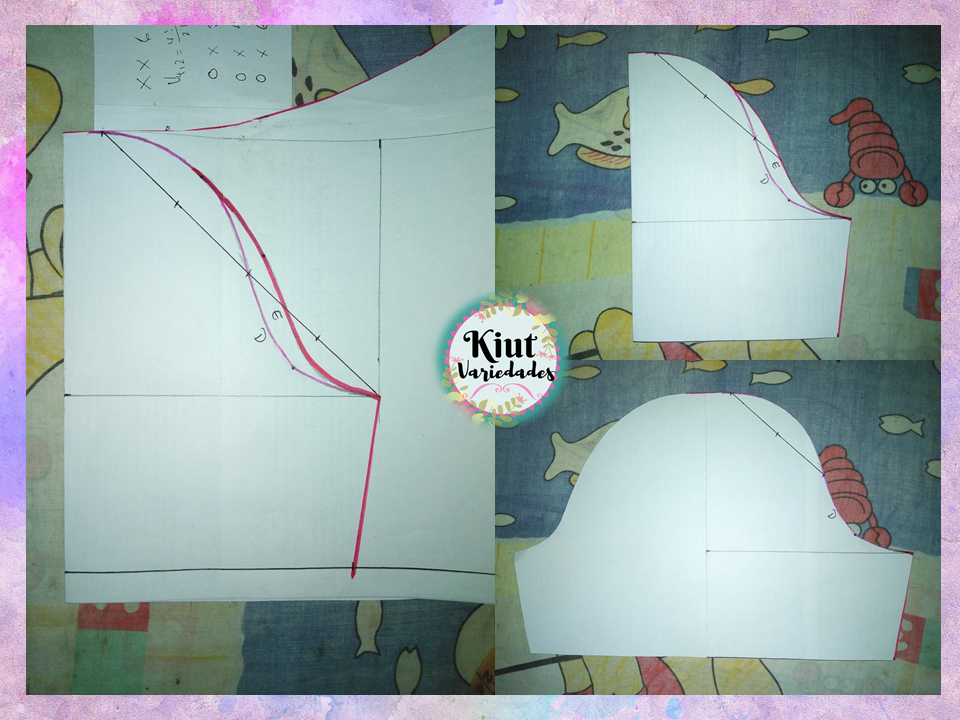


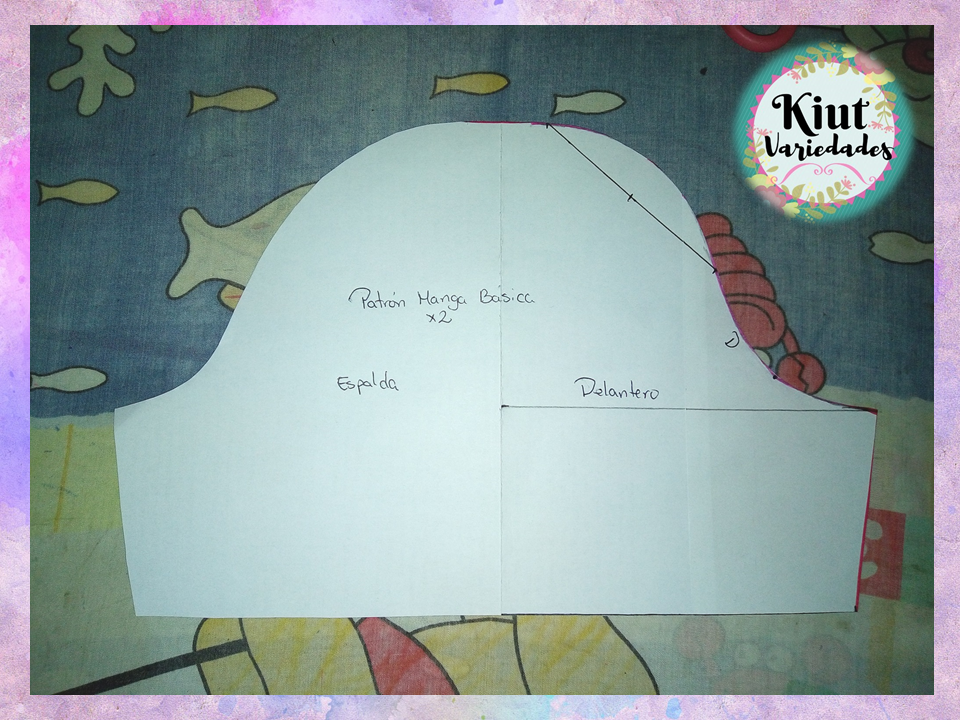


Te invitamos igual que siempre a que intentes este proyecto por tu cuenta y nos cuentes en los comentarios 👇 como es tu experiencia, además te exhortamos a que si lo deseas comiences a emprender tu propio negocio y este proyecto puede ser el inicio.
As always, we invite you to try this project on your own and tell us in the comments 👇 as is your experience, we also urge you to start your own business if you wish and this project can be the beginning.

Síguenos en todas nuestras redes sociales… || Follow us on all our social networks ...
Facebook:KiutVariedades
Instagram:@Kiut_variedades
Twitter:@Kiut_variedades
Excelente tu explicación, yo no coso pero a mi hija le encantan estas cosas, le compartiré tu publicación, Saludos y éxitos!
Hola @yole gracias por visitar nuestro blog y revisar la publicación, la idea es incentivar a las personas a explotar sus habilidades espero que tu hija se anime a realizar alguna de nuestras presentaciones y nos comparta los resultados.
Saludos.!
Excelente post @kiutvariedades, muy explicativo. Ojalá tuviera una maquina de coser para aventurarme en este mundo.